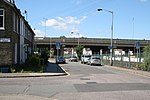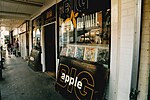House of Reeves

House of Reeves is an independent family-run furniture store in Croydon, southern Greater London, England, founded in 1867. It is located in the Old Town area, and gives its name to Reeves Corner, a road intersection between Church Street and Roman Way, and so to Reeves Corner tram stop. The company came to widespread national public attention in August 2011, when one of its two adjacent buildings was destroyed in an arson attack during the 2011 England riots. Images of the furniture store on fire, with firefighters unable to tackle the blaze because police could not protect them, became symbolic of the violence that spread across the country during several days of rioting and looting. Despite this setback, the company is still trading.
Excerpt from the Wikipedia article House of Reeves (License: CC BY-SA 3.0, Authors, Images).House of Reeves
Reeves Corner, London Broad Green (London Borough of Croydon)
Geographical coordinates (GPS) Address Nearby Places Show on map
Geographical coordinates (GPS)
| Latitude | Longitude |
|---|---|
| N 51.373701 ° | E -0.105623 ° |
Address
Reeves Corner
Reeves Corner
CR9 1QS London, Broad Green (London Borough of Croydon)
England, United Kingdom
Open on Google Maps










